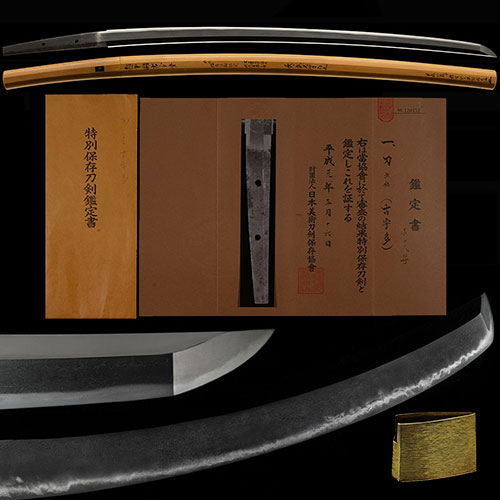
古宇多 刀Kouda Katana
No.488179古宇多 南北朝 時代至徳頃 重要候補傑作 本阿弥日洲鞘書 映り立ち金筋頻りに掛る 二尺四寸Kouda Nanbokuchou period around Shitoku Juyo candidate masterpiece Honaminissyuu Sayagaki Utsuritatsu Kinsuji shikirini-kakaru 72.7cm
ご成約Sold
- 極めKiwame
- 古宇多Kouda
- 登録証Registration
- 東京都 Tokyo 昭和30年12月21日 12/21/30(Showa)
- 法量Size
-
刃長 72.7cm (二尺四寸) 反り 1.7cm
元幅 3.3cm 先幅 2.1cm 元重 0.66cm 鎬厚 0.76cm 先重 0.50cm 鋒長 3.5cm 茎長 19.7cm 重量 830gHachou 72.7cm (二尺四寸) Sori 1.7cm
Moto-Haba 3.3cm Saki-Haba 2.1cm Moto-Kasane 0.66cm Shinogi-Thikess 0.76cm Saki-Kasane 0.50cm Kissaki-Chou 3.5cm Nakago-Chou 19.7cm Weight 830g - 国Country
- 越中Ecchuu
- 姿Shape
- 鎬造、庵棟、身幅広く、反りやや深く、腰反りつき、中鋒やや延びる。Shinogidukuri, Iorimune, Wide Mihaba, Sori a little deeper, Koshizori-tsuki, Chu-kissaki extends a little.
- 鍛Kitae
- 小杢目肌に、板目・杢目肌交じり、地沸微塵に厚くつき、地景よく入り、映りたち、鉄明るく冴える。Small Mokumehada, Mixed Itame and Mokumehada, Jinie is fine and thick, Chikei often entered, Utsuritachi, Iron is bright and clear.
- 刃文Hamon
- 浅くのたれて、小互の目交じり、湯走りかかり、ほつれ・打ちのけ風・食い違い・二十刃かかり、足・葉入り、小沸よくつき、金筋・芋蔓頻りにかかり、匂口明るく冴える。Shallow Notare, Mixed Small Gunome, Yubashiri-kakari, Hotsure, Uchinoke style, Kuichigai, Nijuuba-kakari, There are Ashe and You, Konie often entered, Kinsuji, Imoduru-shikirini-kakari, Nioikuchi is bright and clear.
- 帽子Boushi
- 表のたれて込んで焼き詰め、裏直ぐ調に小丸。The front-notarekonde-yakitsume, The back- sugu-chouni-komaru
- 茎Nakago
- 大磨上、先切、鑢目勝手下り、目釘孔二。Ohsuriage, Sakikiri, Yasurimekattesagari, Mekugiana are 2.
- ハバキHabaki
- 金着一重。Single gold
- 説明Drscription
- 宇多鍛冶は、鎌倉末期に祖古入道国光が、その子、国宗、国房等一族を引き連れ、大和宇陀より越中に移住したのに始まり、南北朝時代から室町時代に渡り繁栄している。その中でも南北朝期までの作を古宇多と呼称していが、南北朝時代に入ると相州伝が加味されていく。この刀は、元は三尺を悠に超える大太刀で、身幅広く3.3cm、重量も830gあり、鋒延びごころの南北朝時代の豪壮な姿で、地景が美しく入る小杢目肌に、映りが鮮やかに立つ明るく冴えた地鉄に、浅くのたれて、小互の目交じり、湯走りかかり、ほつれ・打ちのけ風・食い違い・二十刃かかるなど大和色が強く、足・葉入り、小沸よくつき、金筋・芋蔓頻りにかかり、刃中の働き豊かで、匂口明るく冴える。覇気溢れ、頗る健全な見所の多い傑作刀である。Uta Blacksmith began in the late Kamakura period when his ancestor Ko-nyu-dou Kunimitsu moved to Echichu from Yamato Uda with his children, Kunimune, Kunifusa and other families, and has prospered from the Nanbokuchou period to the Muromachi period.
Among them, the works up to the Nanbokucho period are called Kouda, but in the Nanbokucho period, Soshuden is added.
This sword was originally an Ohtachi that is well over 90 cm, Mihaba is 3.3 cm wide, and weighs 830 g. The magnificent figure of the Nanbokuchou era Kissakinobigokoro and beautiful entered Chikei Small-Mokumehada, Utsuri vividly bright and clear Jitetsu, Shallow Notare, Mixed small-genome, Yubashiri-kakari, Hotsure, Uchinoke style, Kuichigai, Nijuuba-kakaru, It has a strong Yamato style. There are Ashi and You, Konie often entered, Kinsuji and Imoduru shikirini-kakaru. The work in the blade is rich, and Nioikuchi is bright and clear. It is a masterpiece sword that is full of Haki and Kenzen with many highlights.


